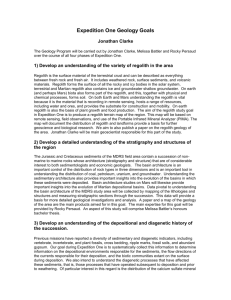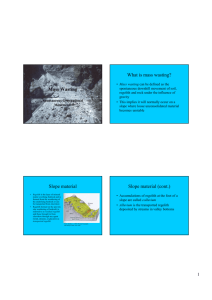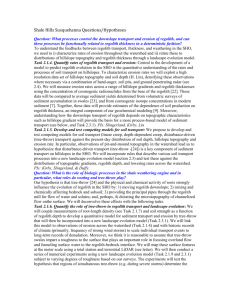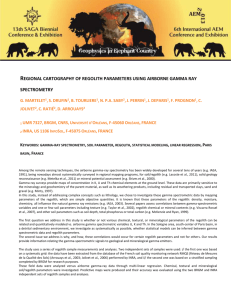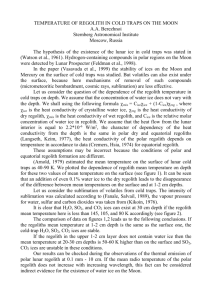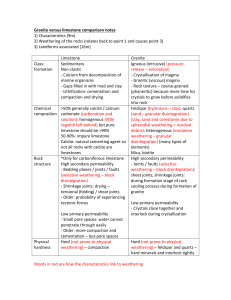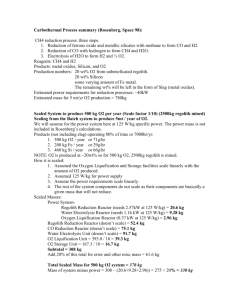MAKING REGOLITH - Educator Section
advertisement
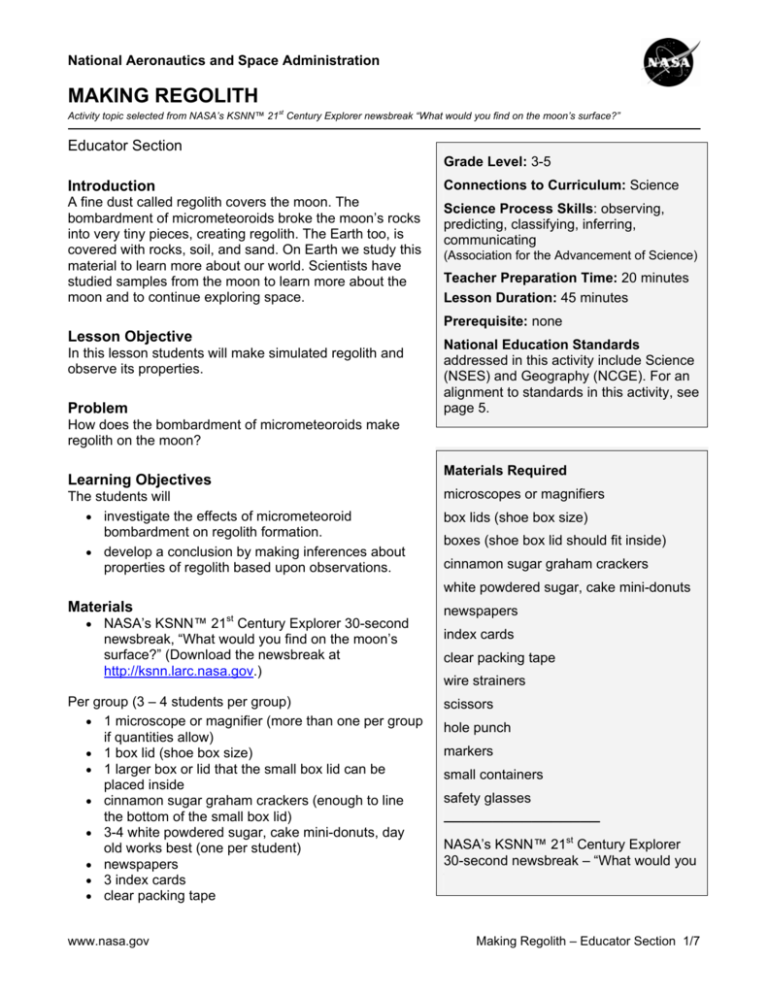
National Aeronautics and Space Administration MAKING REGOLITH st Activity topic selected from NASA’s KSNN™ 21 Century Explorer newsbreak “What would you find on the moon’s surface?” Educator Section Grade Level: 3-5 Introduction Connections to Curriculum: Science A fine dust called regolith covers the moon. The bombardment of micrometeoroids broke the moon’s rocks into very tiny pieces, creating regolith. The Earth too, is covered with rocks, soil, and sand. On Earth we study this material to learn more about our world. Scientists have studied samples from the moon to learn more about the moon and to continue exploring space. Science Process Skills: observing, predicting, classifying, inferring, communicating (Association for the Advancement of Science) Teacher Preparation Time: 20 minutes Lesson Duration: 45 minutes Prerequisite: none Lesson Objective In this lesson students will make simulated regolith and observe its properties. Problem National Education Standards addressed in this activity include Science (NSES) and Geography (NCGE). For an alignment to standards in this activity, see page 5. How does the bombardment of micrometeoroids make regolith on the moon? Learning Objectives The students will • investigate the effects of micrometeoroid bombardment on regolith formation. • develop a conclusion by making inferences about properties of regolith based upon observations. Materials Required microscopes or magnifiers box lids (shoe box size) boxes (shoe box lid should fit inside) cinnamon sugar graham crackers white powdered sugar, cake mini-donuts Materials • NASA’s KSNN™ 21st Century Explorer 30-second newsbreak, “What would you find on the moon’s surface?” (Download the newsbreak at http://ksnn.larc.nasa.gov.) Per group (3 – 4 students per group) • 1 microscope or magnifier (more than one per group if quantities allow) • 1 box lid (shoe box size) • 1 larger box or lid that the small box lid can be placed inside • cinnamon sugar graham crackers (enough to line the bottom of the small box lid) • 3-4 white powdered sugar, cake mini-donuts, day old works best (one per student) • newspapers • 3 index cards • clear packing tape www.nasa.gov newspapers index cards clear packing tape wire strainers scissors hole punch markers small containers safety glasses ──────────────── NASA’s KSNN™ 21st Century Explorer 30-second newsbreak – “What would you find on the moon’s surface?” Making Regolith – Educator Section 1/7 • 2 different sized wire strainers (colander, tea strainer, etc.) or 2 pieces of different sized wire • • • • screens 1 pair of scissors 4 containers for holding sifted regolith 1 hole punch 1 marker Per student • safety glasses • Making Regolith Student Section Safety Remind students about the importance of classroom and lab safety. Students should wear eye protection during this activity. Remind students about the proper use of microscopes and/or magnifying glasses. This activity requires clean up. Pre-lesson Instructions • Students should work in groups of 3 or 4. • The day before this activity take the mini-donuts out of the package, to allow them to dry out. Lesson Development To prepare for this activity, the following background information is recommended: • Read NASA’s KSNN™ 21st Century Explorer Web Text Explanation titled “What would you find on the moon’s surface?” at http://ksnn.larc.nasa.gov. • Read the following text taken from the Observation Section of the Making Regolith Student Section. Observation A fine dust called regolith covers the moon. The bombardment of micrometeoroids broke the moon’s rocks into very tiny pieces, creating regolith. Scientists have studied samples from the moon to learn more about the moon and to continue exploring space. Lunar regolith is about one fifth (1/5) metals and one fifth (1/5) silicon. The rest is mostly oxygen. NASA is looking for ways to pull oxygen from the moon’s surface. Oxygen as a gas could one day support a human base on the moon and fuel vehicles designed to land on and launch from the moon. The particles in lunar regolith are very small (usually less than 0.1 millimeter across). In this experiment, you will make and study simulated regolith samples to observe their properties. • If needed, additional research can be done on the following science topics: o o o o o o www.nasa.gov regolith micrometeoroid bombardment weathering erosion parent rock bedrock Making Regolith – Educator Section 2/7 Instructional Procedure Throughout this lesson, emphasize the steps involved in the scientific method. These steps are identified in bold italic print throughout the Instructional Procedure Section. 1. Show NASA’s KSNN™ 21st Century Explorer newsbreak “What would you find on the moon’s surface?” to engage students and increase student knowledge about this topic. 2. Review the problem with the students. Problem: How does the bombardment of micrometeoroids make regolith on the moon? 3. Have the students read the Observation Section in the Making Regolith Student Section and discuss in their groups. 4. Encourage your students to discuss and make observations about this topic by completing the first two columns in the KWL (KNOW/WANT TO KNOW/LEARNED) chart on the Making Regolith Student Section. Use the KWL chart to help students organize prior knowledge, identify interests, and make real-world connections. As students suggest information for the “KNOW” column, ask them to share “How they have come to know this information.” 5. Ask your students if they have predictions relating to this activity and the “problem question”. Help them refine their predictions into a hypothesis. In their Student Section, they should restate the “problem question” as a statement based upon their observations and predictions. Encourage students to share their hypothesis with their group. 6. Students will test their hypothesis following this procedure. (The following steps are taken from the Student Section. Educator specific comments are in italics.) 1. Put on your safety glasses. Stress the importance of keeping eye protection on during this portion of the lesson. 2. In an open area, spread newspaper on the floor. On the newspaper, place the small box lid inside the larger box lid. The larger box and the newspapers are to catch the crumbs. 3. Spread an even layer of graham crackers on the bottom of the small box lid, simulating the bedrock on the moon. Crush a few graham crackers into very small crumbs and place on top of the bedrock layer. This simulates the moon’s regolith. 4. Let the white powdered sugar, cake mini-donut (micrometeoroid) fall from your hand, from way above your head and into the box with the graham crackers. This “donut dropping” simulates the bombardment of micrometeoroids on the moon. 5. Continue taking turns with your group members, dropping the same donut (micrometeoroid) onto the surface of the moon until regolith is formed (the graham crackers and donuts are crumbs). When the bombardment is finished, the crumbled and broken donuts should stay in the box with the bedrock and regolith. 6. Observe the regolith sample in your box carefully, using the properties your teacher asked you to use. Record your data on the Making Regolith Data Chart. Review with students what properties are to be observed. Suggested properties are roundness, composition, grain size, color, and how the regolith feels when rubbed between your fingers. 7. With the marker, label the four containers with: “Sample A”, “Sample B”, “Sample C” and “Bedrock”. 8. Remove any piece from your box lid that measures one inch or more, and place them in a container labeled “Bedrock”. www.nasa.gov Making Regolith – Educator Section 3/7 9. Using the strainer with the largest holes, sift your regolith sample that is inside the box lid into a clean container (use your other box or lid). Save the large pieces that were caught in the strainer and place these pieces in the container labeled “Sample A”. Demonstrate how to sift the simulated regolith into separate containers. 10. Take what was sifted out of the largest strainer, and sift that with a strainer with smaller holes. Save the pieces that were caught in the strainer and place these pieces in the container labeled “Sample B”. 11. Take what was sifted out of the smaller strainer and put it into the container labeled “Sample C”. This is called “grain size distribution” and is a standard practice when studying soils. Make sure students keep all grain sizes separate. 12. Observe each individual regolith “grain” sample (Samples A – C) carefully, using the properties your teacher asked you to use earlier. Record your data on the Making Regolith Data Sheet. Use the same properties as when recording data earlier. In addition, ask your students to notice the color of the samples; are all the grains in each sample the same color, or different colors? 13. Use the hole punch to make a small circle in the center of three index cards. (See diagram.) Demonstrate steps 13-20, how to make a regolith slide for viewing with the microscope. 14. Cover one side of the hole with clear tape. 15. Trim the index card with scissors so that it fits on the stage of the microscope. 16. Turn the card so the sticky side of the tape is facing up. 17. Label the cards A, B, and C with the marker. 18. Sprinkle a small amount of each sifted regolith sample on the sticky side of the tape, making one slide for each sample. The sample from container “A” should be placed on the index card marked “A”, the sample from container “B” should be placed on the index card marked “B”, and the same for container “C”. 19. Turn the index card on its side and shake off the extra regolith back into the container. 20. Use your magnifying glass or microscope to carefully examine each simulated regolith sample. Make sure you look for all the observable properties you used previously. Record all properties on your Making Regolith Data Sheet. Be sure to draw and describe what you see in your field of view for each sample. Review describing words with your class, using most of your senses. 21. After making all your observations, study the data and draw conclusions by answering the questions following the Making Regolith Data Sheet. Using this information, ask students to determine if the data supports or refutes their hypothesis. www.nasa.gov Making Regolith – Educator Section 4/7 Conclusion • Discuss the answers to the Making Regolith Student Section questions. • Have the students update the LEARNED column in their KWL chart. • Ask students to compare their individual data to the class data. What patterns can be found? • Ask students how their findings relate to the other moons and planets? • Ask students “what they wonder now?” Encourage students to design their own experiments. Assessment • Assess student knowledge through questioning. • Observe and assess student performance throughout the activity using the attached Scientific Investigation Rubric. Activity Alignment to National Education Standards National Science Education Standards (NSES): Content Standard A: Science as Inquiry • Abilities necessary to do scientific inquiry (K-8) • Understandings about scientific inquiry (K-8) Content Standard D: Earth Science • Properties of Earth materials (K-4) U.S. National Geography Standards (NCGE): • Standard 17: How to apply geography to interpret the past Curriculum Explorations To extend the concepts in this activity, the following explorations can be conducted: Mathematics Have the groups of students make pie charts or bar graphs of the weight of each sample; A, B, and C. Have the groups of students make pie charts or bar graphs of the different colors in each individual sample; A, B, and C. Using the entire box of regolith, show the percentage of regolith that was in Sample A, Sample B, and Sample C. Let the students plot points on a graph of the grain size versus weight/volume of each sample; A, B, and C. National Mathematics Education Standards (NCTM) (3-5): Data Analysis and Probability Standard: • Formulate questions that can be addressed with data and collect, organize, and display relevant data to answer them o collect data using observations, surveys, and experiments o represent data using tables and graphs such as line plots, bar graphs, and line graphs • Develop and evaluate inferences and predictions that are based on data o propose and justify conclusions and predictions that are based on data and design studies to further investigate the conclusions or predictions www.nasa.gov Making Regolith – Educator Section 5/7 Language Arts Ask students to explain the experiment. How might students improve this experiment? Where might there have been mistakes made? How might these mistakes have affected the results? Have students use scientific observations to write a story about their simulated regolith sample. Have students describe the simulated regolith’s bedrock: Tell where it could be found and how it was formed. Add illustrations if desired. National Council of Teachers of English Standards (NCTE): • Students conduct research on issues and interests by generating ideas and questions, and by posing problems. They gather, evaluate, and synthesize data from a variety of sources (e.g., print and non-print texts, artifacts, people) to communicate their discoveries in ways that suit their purpose and audience. Sources and Career Links Thanks to subject matter experts Carlton Allen, Dr. Donald Bogard, Dr. Gary Lofgren and Kay Tabola for their contributions to KSNN™ and Noticiencias NASA™ on the development of this education material. More information about Carlton Allen and his work can be found at NASA’s Astromaterials Acquisition and Curation Office at: http://ares.jsc.nasa.gov/People/allencarl.html. Dr. Donald Bogard is a chief scientist for astromaterials at the NASA Johnson Space Center. You can find out more about what he does at: http://ares.jsc.nasa.gov/People/bogarddon.html. Dr. Gary Lofgren is a planetary geoscientist/lunar curator, and director of the experimental petrology laboratory at the NASA Johnson Space Center. Find out more about Dr. Lofgren at this site: http://ares.jsc.nasa.gov/People/lofgrengary.html. Kay Tobola, is an educator for Astromaterials Research and Exploration Science (ARES) at the NASA Johnson Space Center. Learn more about ARES at http://ares.jsc.nasa.gov/. This activity was adapted from existing NASA educational products. Lesson development by the NASA Johnson Space Center Human Health and Performance Education Outreach team. www.nasa.gov Making Regolith – Educator Section 6/7 Scientific Investigation Rubric Experiment: MAKING REGOLITH Student Name __________________________________ Performance Indicator 0 Date ___________________ 1 2 3 4 The student developed a clear and complete hypothesis. The student followed all lab safety rules and directions. The student followed the scientific method. The student recorded all data on the data sheet and drew a conclusion based on the data. The student asked engaging questions related to the study. The student described at least one way that this observation related to the exploration of other moons and planets. Point Total Grading Scale: Point total from above: _________ / (24 possible) A = 22 - 24 points B = 19 - 21 points Grade for this investigation _________________ C = 16 - 18 points D = 13 - 15 points F = 0 - 12 points www.nasa.gov Making Regolith – Educator Section 7/7 National Aeronautics and Space Administration MAKING REGOLITH Student Section Student Name _______________________________ Lesson Objective In this lesson you will make simulated regolith and observe its properties. During this lesson, you will • investigate the effects of micrometeoroid bombardment on regolith formation. • develop a conclusion by making inferences about properties of regolith based upon observations. Problem How does the bombardment of micrometeoroids make regolith on the moon? Observation A fine dust called regolith covers the moon. The bombardment of micrometeoroids broke the moon’s rocks into very tiny pieces, creating regolith. Scientists have studied samples from the moon to learn more about the moon and to continue exploring space. Lunar regolith is about one fifth (1/5) metals and one fifth (1/5) silicon. The rest is mostly oxygen. NASA is looking for ways to pull oxygen from the moon’s surface. Oxygen as a gas could one day support a human base on the moon and fuel vehicles designed to land on and launch from the moon. The particles in lunar regolith are very small (usually less than 0.1 millimeters across). In this experiment, you will make and study simulated regolith samples to observe their properties. Use the first column of this KWL chart to organize your observations about regolith. Brainstorm with your group what you want to know about regolith, then list in the second column of this KWL chart. KNOW www.nasa.gov WANT TO KNOW LEARNED Making Regolith – Student Section 1/5 Hypothesis Based on your observations, answer the “problem question” with your best guess. (How does the bombardment of micrometeoroids make regolith on the moon?) Your hypothesis should be written as a statement. My hypothesis: _____________________________________________________________________ Materials Per student • 1 pair of safety glasses Per group • 1 microscope or magnifier • 1 box lid (shoe box size) • 1 larger box or lid that the small box lid can be placed inside • cinnamon sugar graham crackers (enough to line the bottom of the small box) • 3-4 white powdered sugar, cake mini-donuts (one per student) • newspapers • 3 index cards • clear packing tape • 2 different sized wire strainers (colander, tea strainer, etc) or 2 pieces of different sized wire screens • 1 pair of scissors • 4 containers for holding sifted regolith • 1 hole punch • 1 marker Safety Review your classroom and lab safety rules. Put on safety glasses when instructed. Test Procedure 1. Put on your safety glasses. 2. In an open area, spread newspaper on the floor. On the newspaper, place the small box lid inside the larger box lid. 3. Spread an even layer of graham crackers on the bottom of the small box lid, simulating the bedrock on the moon. Crush a few graham crackers into very small crumbs and place on top of the bedrock layer. This simulates the moon’s regolith. 4. Let the white powdered sugar, cake mini-donut (micrometeoroid) fall from your hand, from way above your head and into the box with the graham crackers. This “donut dropping” simulates the bombardment of micrometeoroids on the moon. 5. Continue taking turns with your group members, dropping the same donut (micrometeoroid) onto the surface of the moon until regolith is formed (the graham crackers and donuts are crumbs). When the bombardment is finished, the crumbled and broken donuts should stay in the box with the bedrock and regolith. 6. Observe the regolith sample in your box carefully, using the properties your teacher asked you to use. Record your data on the Making Regolith Data Chart. www.nasa.gov Making Regolith – Student Section 2/5 7. With the marker, label the four containers with: “Sample A”, “Sample B”, “Sample C” and “Bedrock”. 8. Remove any piece from your box lid that measures one inch or more, and place them in a container labeled “Bedrock”. 9. Using the strainer with the largest holes, sift your regolith sample that is inside the box lid into a clean container (use your other box or lid). Save the large pieces that were caught in the strainer and place these pieces in the container labeled “Sample A”. 10. Take what was sifted out of the largest strainer, and sift that with a strainer with smaller holes. Save the pieces that were caught in the strainer and place these pieces in the container labeled “Sample B”. 11. Take what was sifted out of the smaller strainer and put it into the container labeled “Sample C”. 12. Observe each individual regolith “grain” sample (Samples A – C) carefully, using the properties your teacher asked you to use earlier. Record your data on the Making Regolith Data Sheet. 13. Use the hole punch to make a small circle in the center of three index cards. (See diagram.) 14. Cover one side of the hole with clear tape. 15. Trim the index card with scissors so that it fits on the stage of the microscope. 16. Turn the card so the sticky side of the tape is facing up. 17. Label the cards A, B, and C with the marker. 18. Sprinkle a small amount of each sifted regolith sample on the sticky side of the tape, making one slide for each sample. The sample from container “A” should be placed on the index card marked “A”, the sample from container “B” should be placed on the index card marked “B”, and the same for container “C”. 19. Turn the index card on its side and shake off the extra regolith back into the container. 20. Use your magnifying glass or microscope to carefully examine each simulated regolith sample. Make sure you look for all the observable properties you used previously. Record all properties on your Making Regolith Data Sheet. Be sure to draw and describe what you see in your field of view for each sample. 21. After making all your observations, study the data and draw conclusions by answering the questions following the Making Regolith Data Sheet. www.nasa.gov Making Regolith – Student Section 3/5 Record Data Making Regolith Data Sheet Observations Regolith Sample before it is separated Before sifting the samples, describe the properties of the regolith without using a magnifier or microscope. Observations Sample A Large Pieces Sample B Medium Pieces Sample C Small Pieces Sketch: Sketch: Sketch: Field of view Field of view Field of view Describe: Describe: Describe: After sifting the regolith, what properties can you describe without using a magnifier or microscope? Using the magnifier or microscope, describe what you see using sketches and words. www.nasa.gov Making Regolith – Student Section 4/5 Study Data 1. Based upon your observations, how was your regolith formed? What connection does regolith have to bedrock? 2. How is regolith made on the moon? 3. Compare Earth’s soil to what you know about regolith on the moon. 4. What could we learn about other planets by comparing their regolith to Earth’s soil? 5. Does this data support your hypothesis? Why or why not? 6. How does the atmosphere protect the Earth from this same micrometeoroid bombardment that takes place on the moon? Conclusion • Update the LEARNED column in your KWL chart. • Restate your hypothesis and explain what happened during testing. www.nasa.gov Making Regolith – Student Section 5/5
